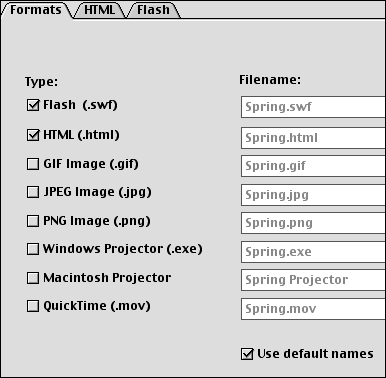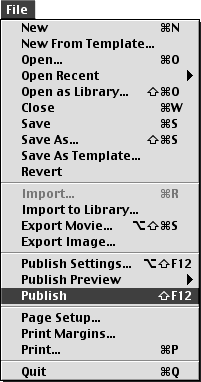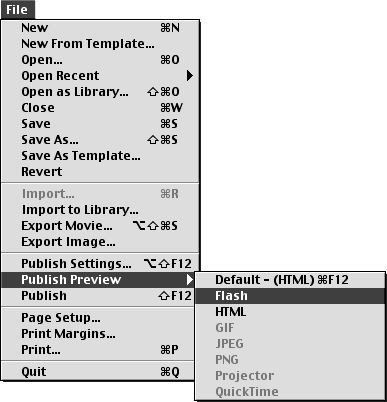| Flash's Publish function is geared toward presenting animation on the Web. The Publish command can create the Flash Player (.swf) file and an HTML document that puts your Flash Player file in a browser window. The Publish command can also create alternative file formatsGIF, JPEG, PNG, and QuickTimeand the HTML need to display them in the browser window. Alternative formats let you make some of the animation and interactivity of your site available even to viewers who lack the Flash plug-in. Flash can also create stand-alone projector files. Flash's Export Movie command exports a movie directly into a single format. In general, the options for exporting from FlashGIF, JPEG, PNG, and QuickTimeare the same as those for publishing to those formats. The arrangement of some options differs between the export and publish dialog boxes, and some formats have more options in the Publish Settings dialog box. In the Publish Settings dialog box, for example, you have the choice to remove gradients from GIFs (to keep the file size small), whereas in the Export GIF dialog box, you don't have that option. Another difference between publishing and exporting is that Flash stores the publish settings with the movie file for reuse. To set a movie's publishing format: -
Open the Flash document that you want to publish. -
From the File menu, choose Publish Settings, or press Option-Shift-F12 (Mac) or Ctrl-Shift-F12 (Windows) (Figure 16.8). The Publish Settings dialog box appears. Figure 16.8. To access the settings for publishing a movie, choose File > Publish Settings.  -
Click the Formats tab (Figure 16.9). Figure 16.9. The Formats tab of the Publish Settings dialog box allows you to publish your Flash movie in as many as seven formats at the same time. You also can create an HTMLdocument for displaying the published files in a browser.  -
Choose one of the eight format options. The formats available are Flash (.swf), HTML (.html), GIF Image (.gif), JPEG Image (.jpg), PNG Image (.png), Windows Projector, Macintosh Projector, and QuickTime (.mov). Choosing HTML automatically selects Flash as well. -
To set the options for a selected format, choose the tab associated with that format (as outlined in separate exercises later in this chapter). -
To save these settings with the current file, click OK. Flash uses these settings each time you choose the Publish or Publish Preview command for this document. Flash also uses a file's current publish settings when you enter test mode (by choosing Control > Test Movie or Control > Test Scene). To publish a movie: -
Open the Flash file that you want to publish. -
To issue the Publish command, do one of the following: -
From the File menu, choose Publish Settings. The Publish Settings dialog box appears. You can follow the steps in the preceding exercise to set new format options or accept the current settings. Then click the Publish button. -
From the File menu, choose Publish, or press Shift-F12 (Figure 16.10). The Publishing dialog box appears, displaying a progress bar and a button for canceling the procedure (Figure 16.11). Flash uses the publish settings that are stored with your Flash document. Figure 16.10. Choose File > Publish to publish the files.  Figure 16.11. To cancel the publishing process, click the Stop (Mac) or Cancel (Windows) button in the Publishing dialog box.  Flash creates a new file for each format that is selected in the Publish Settings dialog box. By default, Flash places the published files in the same location as the original Flash file.  Tips Tips -
You can open your browser and preview a movie in one step. Choose File > Publish Preview. Flash offers a menu that contains all the formats selected in the Publish Settings dialog box (Figure 16.12). Choose a format. Flash publishes the file in that format, using the current settings, and opens the movie in a browser window. Figure 16.12. The File >Publish Preview submenu displays all the formats that are selected in the Publish Settings dialog box. Flash publishes your movie in the selected format and opens it in your browser.  -
Flash makes one of the formats the default for Publish Preview. To publish in the default format, press  -F12 (Mac) or Ctrl-F12 (Windows). If you want to do lots of testing in a format other than SWF (if you want to test your animated GIF versions, for example), set your publish settings in only that format. Then that format will be the default, and you can choose it quickly by pressing -F12 (Mac) or Ctrl-F12 (Windows). If you want to do lots of testing in a format other than SWF (if you want to test your animated GIF versions, for example), set your publish settings in only that format. Then that format will be the default, and you can choose it quickly by pressing  -F12 (Mac) or Ctrl-F12 (Windows). -F12 (Mac) or Ctrl-F12 (Windows). -
By default, Flash names the published files by adding the appropriate extension to the file name , adding .gif for a GIF file or .png for a PNG file, for example. To create your own file names, deselect the Use Default Names option in the Filename section of the Publish Settings dialog box (Figure 16.13). Figure 16.13. To enter your own file names, first deselect Use Default Names in the Filename section of the Publish Settings dialog box. Be sure to enter the .swf extension at the end of the file name.  -
The Publish and Publish Preview commands do not give you a chance to name the published files; they take the names directly from the Publish Settings dialog box. If you want to publish multiple versions of a movie, each with different settings, you must make sure that you don't overwrite the published file. Rename the published file, move that file to a new location, or type a different name in the Formats tab of the Publish Settings dialog box.
|




